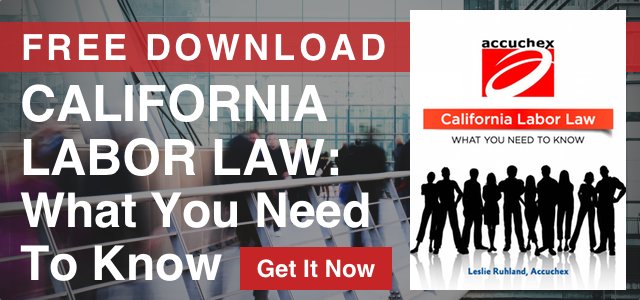
Is it legal for an employer to combine two 10-minute rest breaks into a single, 20-minute rest period? According to a California appellate panel, California break laws allow it - perhaps.
The management at a metal finishing shop had long combined the two required breaks for a single, longer morning rest period. But a former employee filed suit, alleging that the practice violated Wage Order No. 1-2001, which states that employee rest periods should occur in the middle of each work period "insofar as practicable."
Court Rulings on California Break Laws Provide (Some) Clarity
The California Court of Appeals recently held that California employers may not combine required 10 minute rest periods into one larger rest period absent justifiable circumstances, further clarifying the California Supreme Court’s decision in Brinker Restaurant Corp. v. Superior Court, which had held that employers were not always required to provide a rest period before a meal break.
This ruling suggested, in effect, that they may in fact be combined.
Rodriguez v. E.M.E., Inc., (Second Appellate District,), was decided on April 22, 2016 and involved a metal finishing shop that had a 30-year long practice of combining two daily 10-minute rest breaks into one 20-minute break each morning. According to the owners, management and employees had reached an informal agreement that combining the breaks was preferred over two 10-minute breaks.
Most of the employees preferred the extended time as it allowed them to cook morning meals. In addition, because the production had to be shut down and reactivated for every break, the production line would lose 20 minutes for every break. Thus, a combined break also served to increased productivity.
However, a former employee filed a class action complaint against E.M.E., Inc., claiming that the rest break practice violated California law. The employee insisted that the California Labor Code and the applicable wage order mandated that employers take two separate 10-minute rest breaks during an 8 hour shift, one before the meal break and one after.
The employee disputed the company’s contention that a combined break was necessary. He testified that the time necessary to shut down and start the production line was “20-30 seconds at most", not the 20 minutes maintained by the company.
Understanding California Break Laws
According to the California Labor Code, Wage Order No. 1, which covers the manufacturing industry:
Every employer shall authorize and permit all employees to take rest periods, which insofar as practicable shall be in the middle of each work period. The authorized rest period time shall be based on the total hours worked daily at the rate of ten (10) minutes net rest time per four (4) hours or major fraction thereof.
Under the wage order, employers must provide all employees with a 10 minute paid rest period for every four hours, or major fraction thereof, worked. If an employer fails to provide a required rest period, the employer must pay a wage penalty equivalent to one hour of pay at the employee’s regular rate of pay for each workday that the rest period was not provided.
The wage orders do not, however, specify whether an employer may satisfy its obligations under the law by providing one combined rest period rather than separate 10 minute periods. The orders only specify that they should fall in the middle of work periods “insofar as practicable.”
Ensuring Compliance With California Break Laws
California’s meal and rest period rules are extremely technical and complex. To comply with the law, California employers will want to adopt carefully worded break policies and train managers and supervisors on how to properly implement these policies.
As a general rule, for an eight hour shift, one 10-minute break should take place in the middle of the first work period before the meal break, and a second rest break should take place in the middle of the second work period after the meal break.
This case indicates that employers should use great caution whenever deviating from the general rule that rest periods must be provided in separate 10 minute increments on both sides of a meal period (where applicable). Employers must be prepared to affirmatively and definitively demonstrate a material burden on their operations. This is true even if employees prefer, or even requested, the change to scheduling, as was the case in Rodriguez.
Help With Complying With California Labor Law
If your organization would like to learn more about its obligations, or acquire resources to deal with these types of situations, Accuchex recently partnered with HR Solutions Partners to offer its customers the most up-to-date and professional human resources management solutions available.
To learn more about the different levels of Human Resource Management services available, please follow this link.
To learn more about the services Accuchex provides, click on the button below to download our free guidebook.


